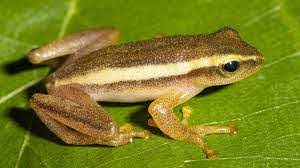
In News
Scientists discovered a new genus of tree frogs.
In-Detail
- Researchers from the University of Delhi and the Zoological Survey of India (ZSI) discovered a new genus of tree frogs.
- The tree frogs are found in the Andaman Islands and the Northeast.
- The tree frog is named Rohanixalus after the Sri Lankan taxonomist Rohan Pethiyagoda.
- The frogs of the new genus have a small and slender body with a size of about 2 to 3cm.
- They have a pair of contrastingly coloured lateral lines on either side of the body with tiny brown speckles scattered throughout the upper body.
- the frogs lay eggs in arboreal bubble-nests which are light green.
- Using DNA sequencing, researchers have found that the new genus is the distinct evolutionary lineage from previously known tree frog genera.
- Scientists studied the external morphology of adults and tadpoles, calls, phylogeny and breeding biology of tree frog species.
- These frogs are distributed across South, Southeast and East Asia.
- The study was contributed by scientists from China, Indonesia and Thailand.
- The tree frog belongs to the family of Rhacophoridae is the 20th recognized genus that comprises 422 known Old World tree frog species that are found in Asia and Africa.
- There are 8 frog species in the genus Rohanixalus and are known to inhabit the forest as well as human-dominated landscapes.
- These are mostly found in the northeast, Andaman Islands, Thailand, Malaysia, Myanmar, Laos, Vietnam, Indonesia and Cambodia and Southern China.
- Rohanixalus vittatus (Stripped Bubble nest frog) is the first member of the tree frog family and is found on the Andaman Island.
- This research uncovers the new distribution pattern of tree frogs which provides evidence for faunal exchange between Andamans and the Indo-Burma region.
Feature of the New Tree Frog
- The genus has a unique behavioural trait of maternal egg attendance.
- The female frogs watch over the egg clutches until tadpoles are hatched and the female frog assists the tadpoles into the water.
- The females sit over the eggs during the first three days after laying eggs.
- They produce a gelatinous secretion with which she glazes the egg mass through the clockwise movement of her legs.
- This produces necessary moisture to the eggs laid on exposed leaf surfaces and protects from insect prediction.
- Field studies revealed that the frogs lay eggs in clutches and the researchers have founds eggs at various developmental stages on a single leaf or plant.
- The frogs all display territorial behavior and frequent male-male combats which involve pushing, kicking, and dislodging to successfully mate with the female.

Leave a Reply
You must be logged in to post a comment.